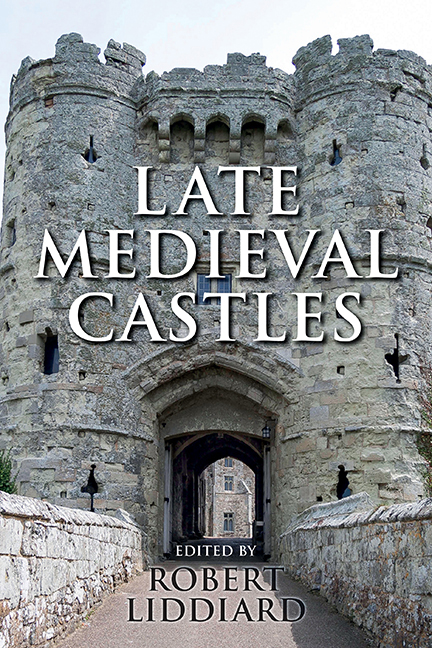Book contents
- Frontmatter
- Contents
- List of Illustrations
- Acknowledgements
- Editor's Preface
- List of Abbreviations
- A Note on the Text
- Introduction
- 1 Fourteenth-Century Castles in Context: Apotheosis or Decline?
- 2 Architects, Advisors and Design at Edward I's Castles in Wales
- 3 The Courtyard and the Tower: Contexts and Symbols in the Development of Late Medieval Great Houses
- 4 Castle Planning in the Fourteenth Century
- 5 Meaningful Constructions: Spatial and Functional Analysis of Medieval Buildings
- 6 Mota, Aula et Turris: The Manor-Houses of the Anglo-Scottish Border
- 7 Lulworth Castle, Dorset
- 8 A Scottish Problem with Castles
- 9 Structural Symbolism in Medieval Castle Architecture
- 10 Specimens of Freedom to Crenellate by Licence
- 11 Some Analysis of the Castle of Bodiam, East Sussex
- 12 English Castles in the Reign Of Edward II
- 13 Castles of Ward and the Changing Pattern of Border Conflict in Ireland
- 14 The Donjon Of Knaresborough: The Castle As Theatre
- 15 The Architecture of Arthurian Enthusiasm: Castle Symbolism in the Reigns of Edward I and his Successors
- 16 Medieval Ornamental Landscapes
- 17 Otherworld Castles in Middle English Arthurian Romance
- Guide to Further Reading
- Index
1 - Fourteenth-Century Castles in Context: Apotheosis or Decline?
Published online by Cambridge University Press: 29 April 2017
- Frontmatter
- Contents
- List of Illustrations
- Acknowledgements
- Editor's Preface
- List of Abbreviations
- A Note on the Text
- Introduction
- 1 Fourteenth-Century Castles in Context: Apotheosis or Decline?
- 2 Architects, Advisors and Design at Edward I's Castles in Wales
- 3 The Courtyard and the Tower: Contexts and Symbols in the Development of Late Medieval Great Houses
- 4 Castle Planning in the Fourteenth Century
- 5 Meaningful Constructions: Spatial and Functional Analysis of Medieval Buildings
- 6 Mota, Aula et Turris: The Manor-Houses of the Anglo-Scottish Border
- 7 Lulworth Castle, Dorset
- 8 A Scottish Problem with Castles
- 9 Structural Symbolism in Medieval Castle Architecture
- 10 Specimens of Freedom to Crenellate by Licence
- 11 Some Analysis of the Castle of Bodiam, East Sussex
- 12 English Castles in the Reign Of Edward II
- 13 Castles of Ward and the Changing Pattern of Border Conflict in Ireland
- 14 The Donjon Of Knaresborough: The Castle As Theatre
- 15 The Architecture of Arthurian Enthusiasm: Castle Symbolism in the Reigns of Edward I and his Successors
- 16 Medieval Ornamental Landscapes
- 17 Otherworld Castles in Middle English Arthurian Romance
- Guide to Further Reading
- Index
Summary
Convention has dealt harshly with English castle-architecture after the ‘great days’ of Edward I. The fourteenth century can boast such remarkable structures as Thomas of Lancaster's additions to Pontefract (Yorks.), Edward III's sumptuous rebuilding at Windsor (Berks.), Edmund of Langley's Fotheringhay (Northants.), with its once-allusive ‘fetterlock’ plan, and the surviving spectacular north-east front of the Beauchamps’ Warwick. Yet paradoxically, these and lesser displays of power (such as Bodiam, Bolton, Cooling, Donnington, Lumley, Max-stoke, Nunney, Raby, Sheriff Hutton, Shirburn, Wardour, Wingfield and Wressel) tend to disappoint popular expectations. These and many others, less familiar, can seem too ‘domestic’. ‘Castles’ must be ‘seriously fortified’ and above suspicion of being castellated palaces. Appreciating them correctly calls for a different approach. It is not enough to accept residence as a proper purpose, but reduced to a subordinate by-product of ‘strategic necessity’. Although the concept of ‘castles of chivalry’ has modified the utilitarian and ‘functional’ approach, the stigma of ‘decline’ persists. Architectural historians, with a different interpretative agenda, rely more on individual structure and detail – but as Paul Frankl noted, ‘there is, as yet, no terminology for the styles of military architecture, and this is a subject to which more thought might profitably be devoted’. This remains the position.
The unity of medieval noble architecture, when contemplated entire, overwhelms the specialisms ‘religious’, ‘military’, ‘civil’, ‘domestic’, or merely ecclesiastical and secular, initiated by Arcisse de Caumont (1802–73). But art-historical method still genuflects to architectural Darwinism. Only recently has ‘the survival of the fittest’ fallen from favour as prime mover of castle-development. Doubts have most crucially focused on the twelfth century. Matthew Strickland has emphasised the powerlessness, quite often, of unsupported English castles in face of even ill-equipped Scots. In 1173, the major fortress of Warkworth was abandoned as ‘indefensible against a major Scottish invasion’, although it was always ‘a fortified seigneurial residence’ discharging ‘the administrative functions of lordship’. Because the military hypothesis began with ‘the Normans’, any revision has deep historical implications, especially for the castles of the fourteenth century. Detailed discussion must begin with a reappraisal of the early castles.
- Type
- Chapter
- Information
- Late Medieval Castles , pp. 19 - 40Publisher: Boydell & BrewerPrint publication year: 2016



